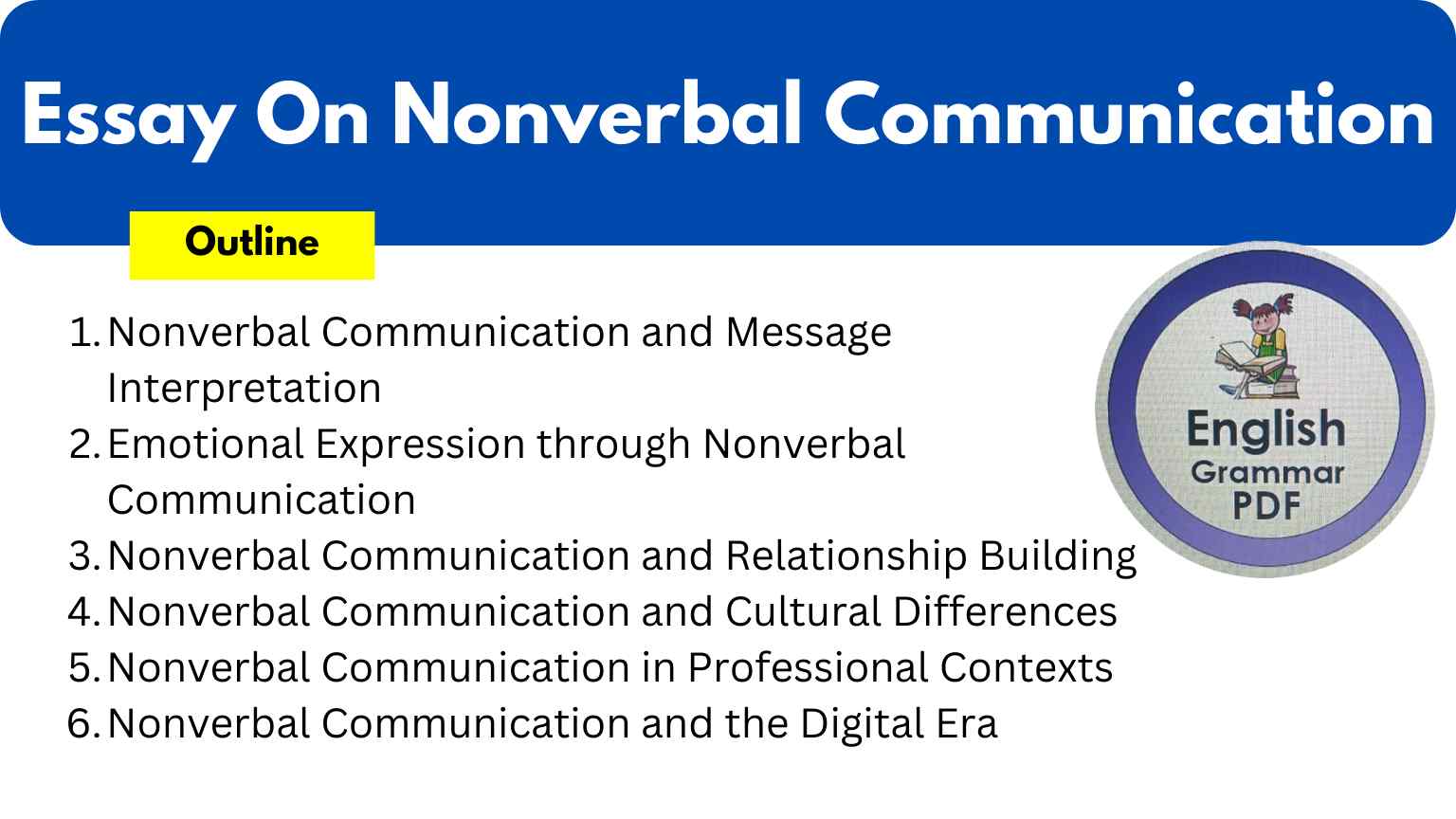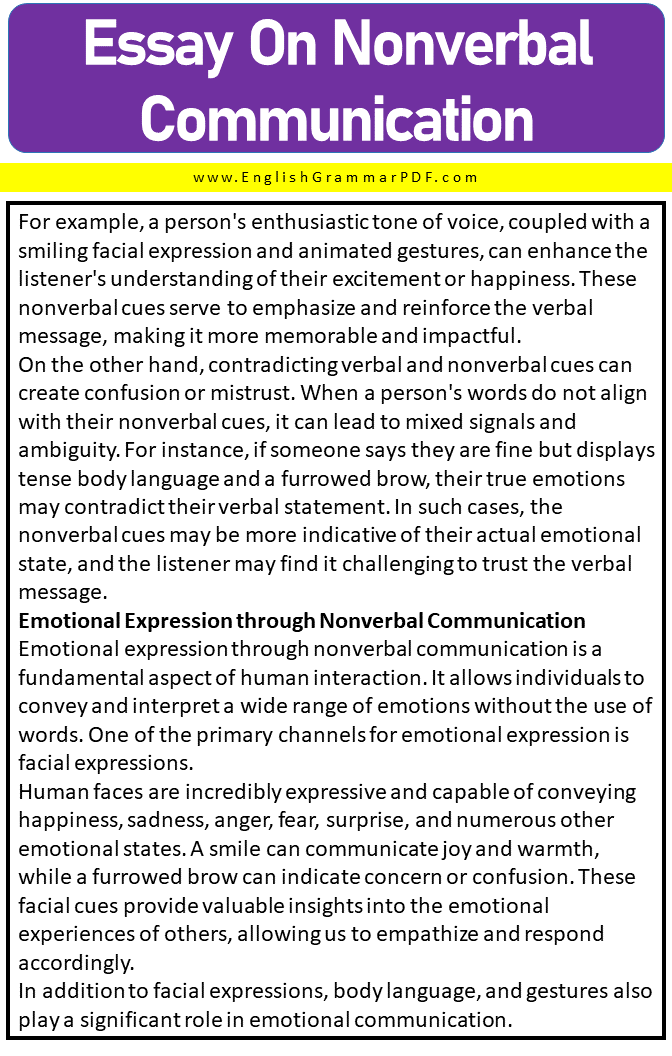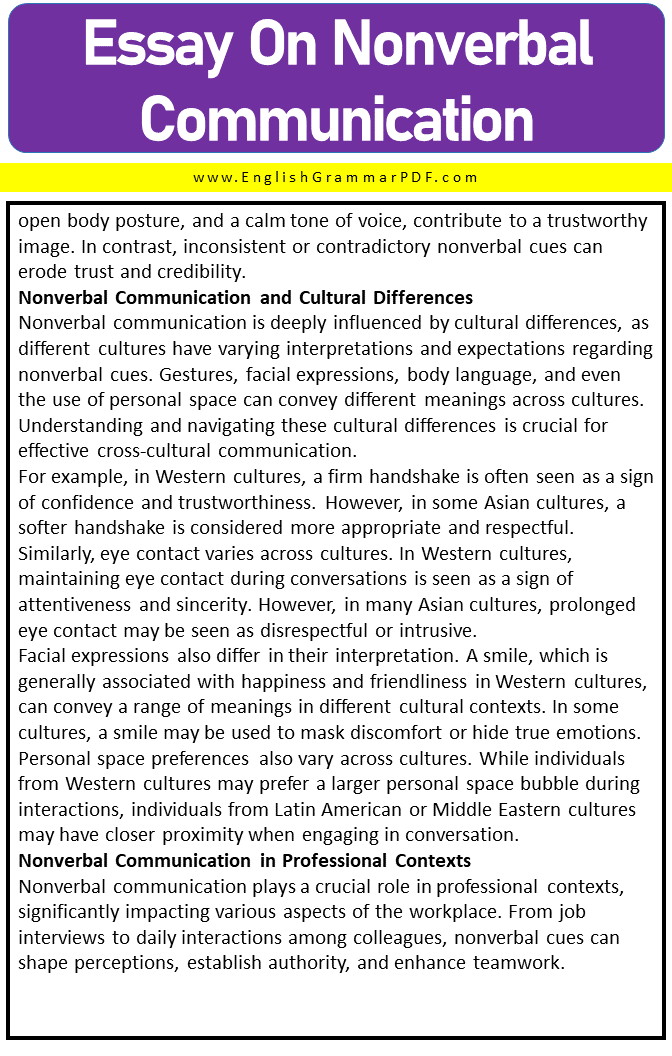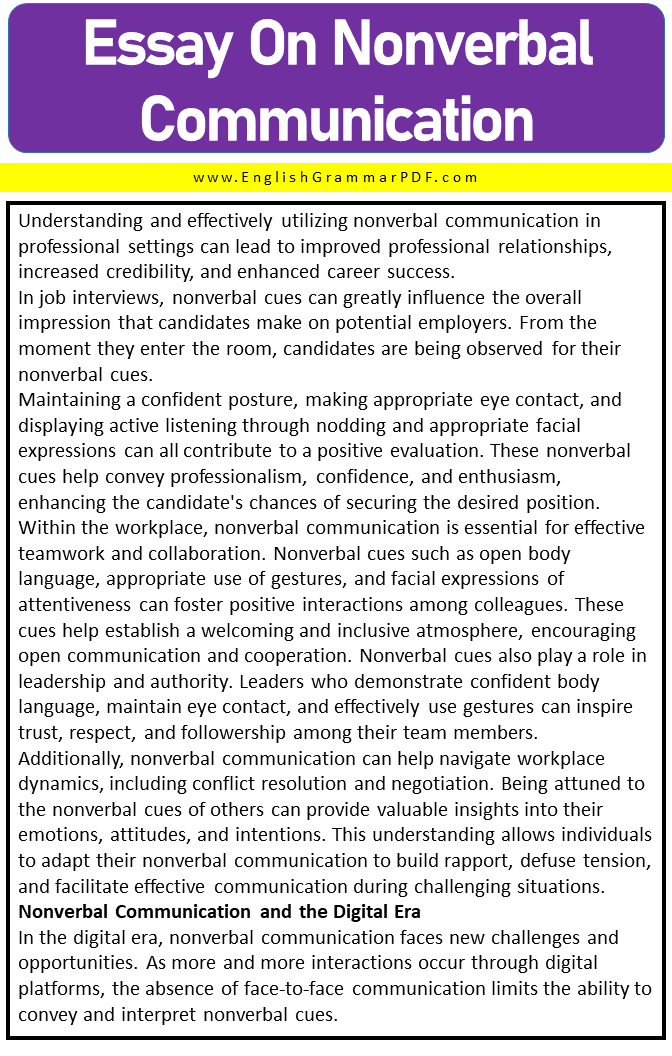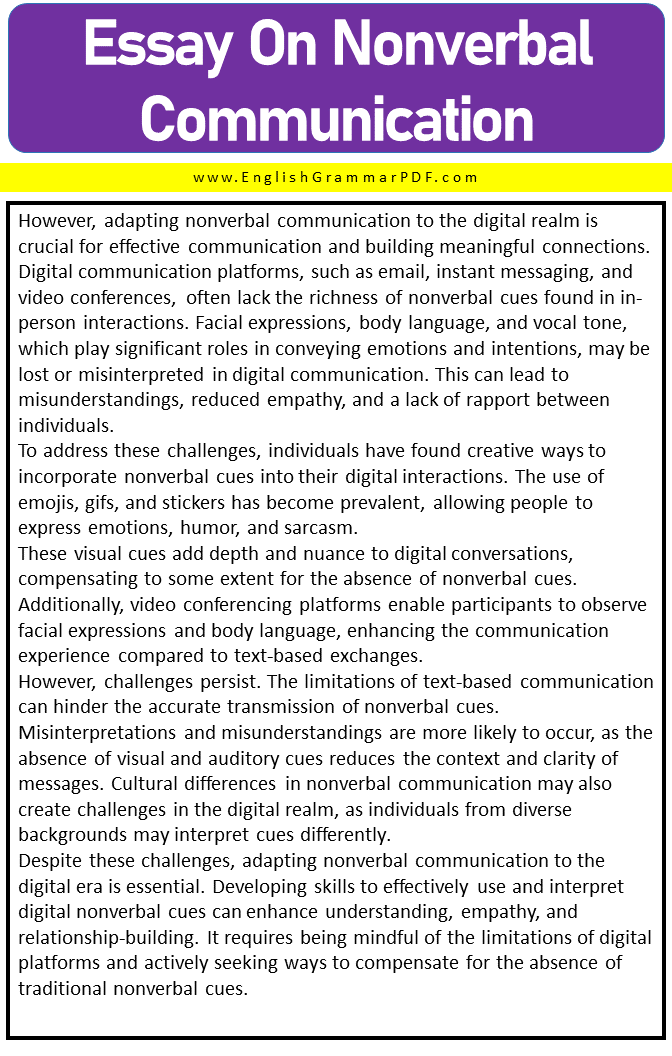Essay On Nonverbal Communication
Outline of Essay:
- Introduction
- Nonverbal Communication and Message Interpretation
- Emotional Expression through Nonverbal Communication
- Nonverbal Communication and Relationship Building
- Nonverbal Communication and Cultural Differences
- Nonverbal Communication in Professional Contexts
- Nonverbal Communication and the Digital Era
Introduction
Nonverbal communication is a form of communication that does not involve the use of spoken or written words. It encompasses various nonverbal cues, such as facial expressions, body language, gestures, and vocal tone. In human interactions, nonverbal communication plays a crucial role in conveying messages, establishing relationships, and enhancing understanding. This essay explores the importance of nonverbal communication in various aspects of life and emphasizes its significance in effective communication.
Nonverbal Communication and Message Interpretation
Nonverbal communication plays a crucial role in the interpretation of messages. While verbal communication relies on spoken or written words, nonverbal cues provide additional meaning and context, enriching the overall message. Nonverbal cues can complement or contradict verbal messages, significantly influencing how messages are interpreted and understood.
When nonverbal cues complement verbal messages, they reinforce the meaning and intent behind the spoken words. For example, a person’s enthusiastic tone of voice, coupled with a smiling facial expression and animated gestures, can enhance the listener’s understanding of their excitement or happiness. These nonverbal cues serve to emphasize and reinforce the verbal message, making it more memorable and impactful.
On the other hand, contradicting verbal and nonverbal cues can create confusion or mistrust. When a person’s words do not align with their nonverbal cues, it can lead to mixed signals and ambiguity. For instance, if someone says they are fine but displays tense body language and a furrowed brow, their true emotions may contradict their verbal statement. In such cases, the nonverbal cues may be more indicative of their actual emotional state, and the listener may find it challenging to trust the verbal message.
Emotional Expression through Nonverbal Communication
Emotional expression through nonverbal communication is a fundamental aspect of human interaction. It allows individuals to convey and interpret a wide range of emotions without the use of words. One of the primary channels for emotional expression is facial expressions.
Human faces are incredibly expressive and capable of conveying happiness, sadness, anger, fear, surprise, and numerous other emotional states. A smile can communicate joy and warmth, while a furrowed brow can indicate concern or confusion. These facial cues provide valuable insights into the emotional experiences of others, allowing us to empathize and respond accordingly.
In addition to facial expressions, body language, and gestures also play a significant role in emotional communication. Posture, hand movements, and other bodily cues can convey a person’s emotional state. For instance, slumped shoulders and a lowered head might indicate sadness or dejection, while an upright posture and confident stride can convey feelings of confidence and assertiveness.
Gestures, such as clenched fists or crossed arms, can reveal anger or defensiveness. By observing and interpreting these nonverbal cues, individuals can gauge the emotional atmosphere of a situation and adjust their responses accordingly.
Accurate interpretation of emotional and nonverbal cues is crucial for effective communication and interpersonal relationships. It allows us to understand the emotions of others, enabling empathy and compassion. Furthermore, it enhances our ability to express our own emotions, providing a means to communicate our needs, desires, and concerns without relying solely on words.
Nonverbal Communication and Relationship Building
Nonverbal communication plays a crucial role in relationship building, fostering connections, and establishing trust between individuals. While verbal communication conveys the content of our messages, nonverbal cues provide additional layers of meaning, emotional expression, and relational information.
Nonverbal cues, such as facial expressions, body language, and gestures, contribute to the overall impression we create and the quality of our interactions. Maintaining eye contact, for example, signals attentiveness and interest, making the other person feel valued and heard. Smiling and nodding convey warmth and affirmation, fostering positive rapport and creating a sense of connection. Conversely, crossed arms, averted gaze, or tense body language can signal disinterest, defensiveness, or discomfort, hindering relationship development.
Furthermore, nonverbal communication helps establish trust. Trust is built not only through what is said but also through nonverbal cues that signal authenticity, reliability, and honesty. Nonverbal cues that demonstrate sincerity, such as maintaining eye contact, open body posture, and a calm tone of voice, contribute to a trustworthy image. In contrast, inconsistent or contradictory nonverbal cues can erode trust and credibility.
Nonverbal Communication and Cultural Differences
Nonverbal communication is deeply influenced by cultural differences, as different cultures have varying interpretations and expectations regarding nonverbal cues. Gestures, facial expressions, body language, and even the use of personal space can convey different meanings across cultures. Understanding and navigating these cultural differences is crucial for effective cross-cultural communication.
For example, in Western cultures, a firm handshake is often seen as a sign of confidence and trustworthiness. However, in some Asian cultures, a softer handshake is considered more appropriate and respectful. Similarly, eye contact varies across cultures. In Western cultures, maintaining eye contact during conversations is seen as a sign of attentiveness and sincerity. However, in many Asian cultures, prolonged eye contact may be seen as disrespectful or intrusive.
Facial expressions also differ in their interpretation. A smile, which is generally associated with happiness and friendliness in Western cultures, can convey a range of meanings in different cultural contexts. In some cultures, a smile may be used to mask discomfort or hide true emotions.
Personal space preferences also vary across cultures. While individuals from Western cultures may prefer a larger personal space bubble during interactions, individuals from Latin American or Middle Eastern cultures may have closer proximity when engaging in conversation.
Nonverbal Communication in Professional Contexts
Nonverbal communication plays a crucial role in professional contexts, significantly impacting various aspects of the workplace. From job interviews to daily interactions among colleagues, nonverbal cues can shape perceptions, establish authority, and enhance teamwork. Understanding and effectively utilizing nonverbal communication in professional settings can lead to improved professional relationships, increased credibility, and enhanced career success.
In job interviews, nonverbal cues can greatly influence the overall impression that candidates make on potential employers. From the moment they enter the room, candidates are being observed for their nonverbal cues.
Maintaining a confident posture, making appropriate eye contact, and displaying active listening through nodding and appropriate facial expressions can all contribute to a positive evaluation. These nonverbal cues help convey professionalism, confidence, and enthusiasm, enhancing the candidate’s chances of securing the desired position.
Within the workplace, nonverbal communication is essential for effective teamwork and collaboration. Nonverbal cues such as open body language, appropriate use of gestures, and facial expressions of attentiveness can foster positive interactions among colleagues. These cues help establish a welcoming and inclusive atmosphere, encouraging open communication and cooperation. Nonverbal cues also play a role in leadership and authority. Leaders who demonstrate confident body language, maintain eye contact, and effectively use gestures can inspire trust, respect, and followership among their team members.
Additionally, nonverbal communication can help navigate workplace dynamics, including conflict resolution and negotiation. Being attuned to the nonverbal cues of others can provide valuable insights into their emotions, attitudes, and intentions. This understanding allows individuals to adapt their nonverbal communication to build rapport, defuse tension, and facilitate effective communication during challenging situations.
Nonverbal Communication and the Digital Era
In the digital era, nonverbal communication faces new challenges and opportunities. As more and more interactions occur through digital platforms, the absence of face-to-face communication limits the ability to convey and interpret nonverbal cues. However, adapting nonverbal communication to the digital realm is crucial for effective communication and building meaningful connections.
Digital communication platforms, such as email, instant messaging, and video conferences, often lack the richness of nonverbal cues found in in-person interactions. Facial expressions, body language, and vocal tone, which play significant roles in conveying emotions and intentions, may be lost or misinterpreted in digital communication. This can lead to misunderstandings, reduced empathy, and a lack of rapport between individuals.
To address these challenges, individuals have found creative ways to incorporate nonverbal cues into their digital interactions. The use of emojis, gifs, and stickers has become prevalent, allowing people to express emotions, humor, and sarcasm.
These visual cues add depth and nuance to digital conversations, compensating to some extent for the absence of nonverbal cues. Additionally, video conferencing platforms enable participants to observe facial expressions and body language, enhancing the communication experience compared to text-based exchanges.
However, challenges persist. The limitations of text-based communication can hinder the accurate transmission of nonverbal cues. Misinterpretations and misunderstandings are more likely to occur, as the absence of visual and auditory cues reduces the context and clarity of messages. Cultural differences in nonverbal communication may also create challenges in the digital realm, as individuals from diverse backgrounds may interpret cues differently.
Despite these challenges, adapting nonverbal communication to the digital era is essential. Developing skills to effectively use and interpret digital nonverbal cues can enhance understanding, empathy, and relationship-building. It requires being mindful of the limitations of digital platforms and actively seeking ways to compensate for the absence of traditional nonverbal cues. By leveraging the available tools and constantly improving digital communication skills, individuals can overcome challenges and maximize the potential of nonverbal communication in the digital era.
FAQ’s
What is the purpose of non-verbal communication?
The purpose of nonverbal communication is to enhance and complement verbal messages. It helps convey emotions, attitudes, and intentions, establish rapport, and provide additional information that enriches the understanding of spoken or written words.
How can I improve my nonverbal communication skills?
Improving nonverbal communication skills involves several strategies. These include practicing active listening, being aware of your body language and facial expressions, maintaining eye contact, using appropriate gestures, and adapting your nonverbal cues to different contexts and cultural norms. Seeking feedback and observing others’ nonverbal behavior can also contribute to skill enhancement.
Download the PDF of the Essay:
Explore More Essays:
